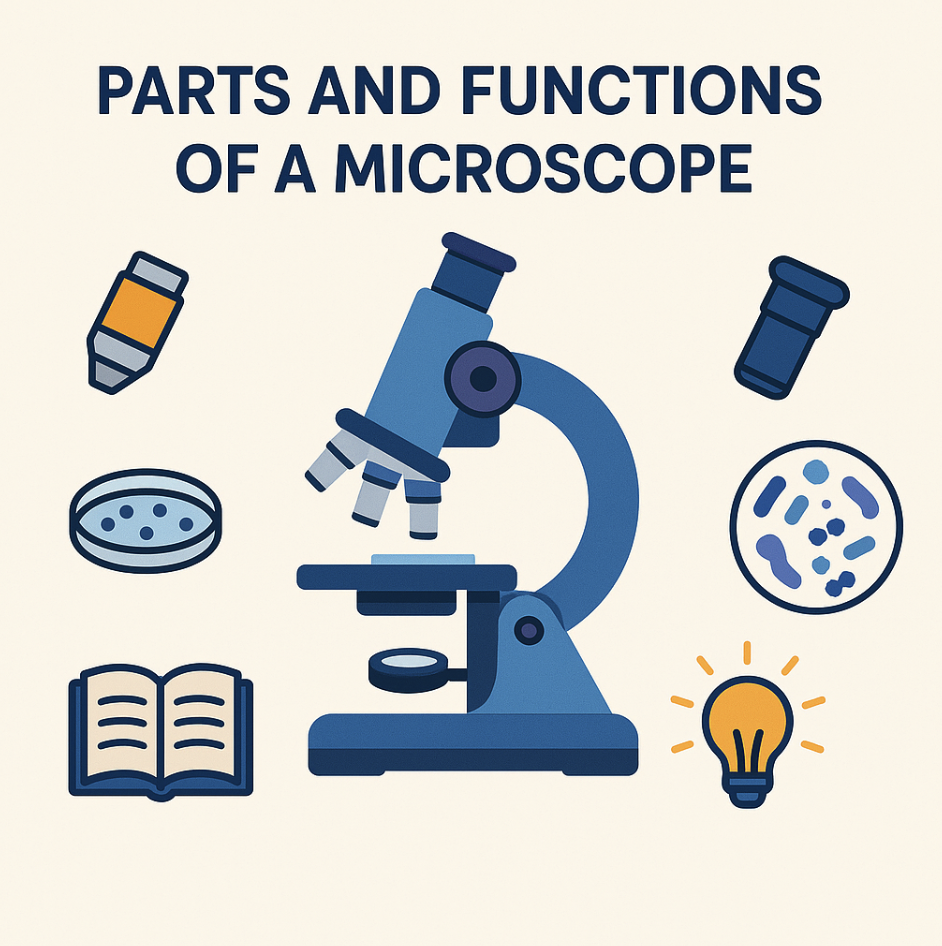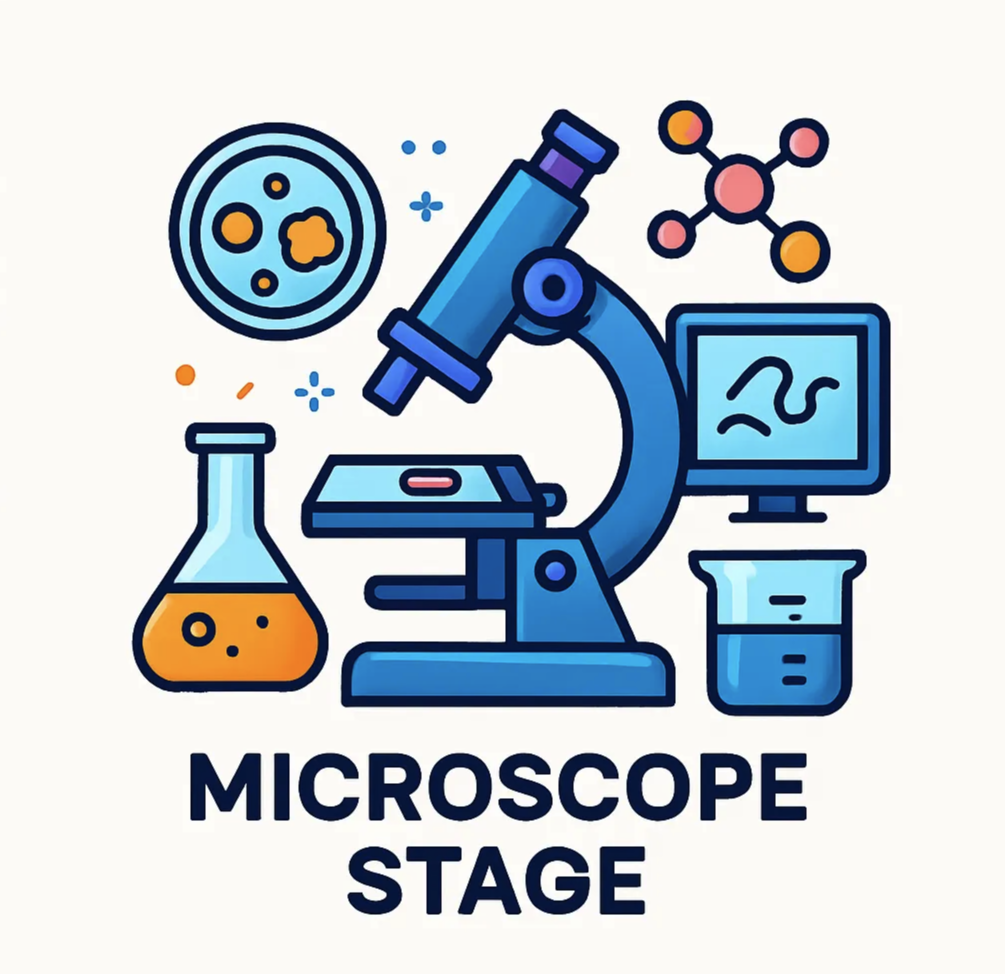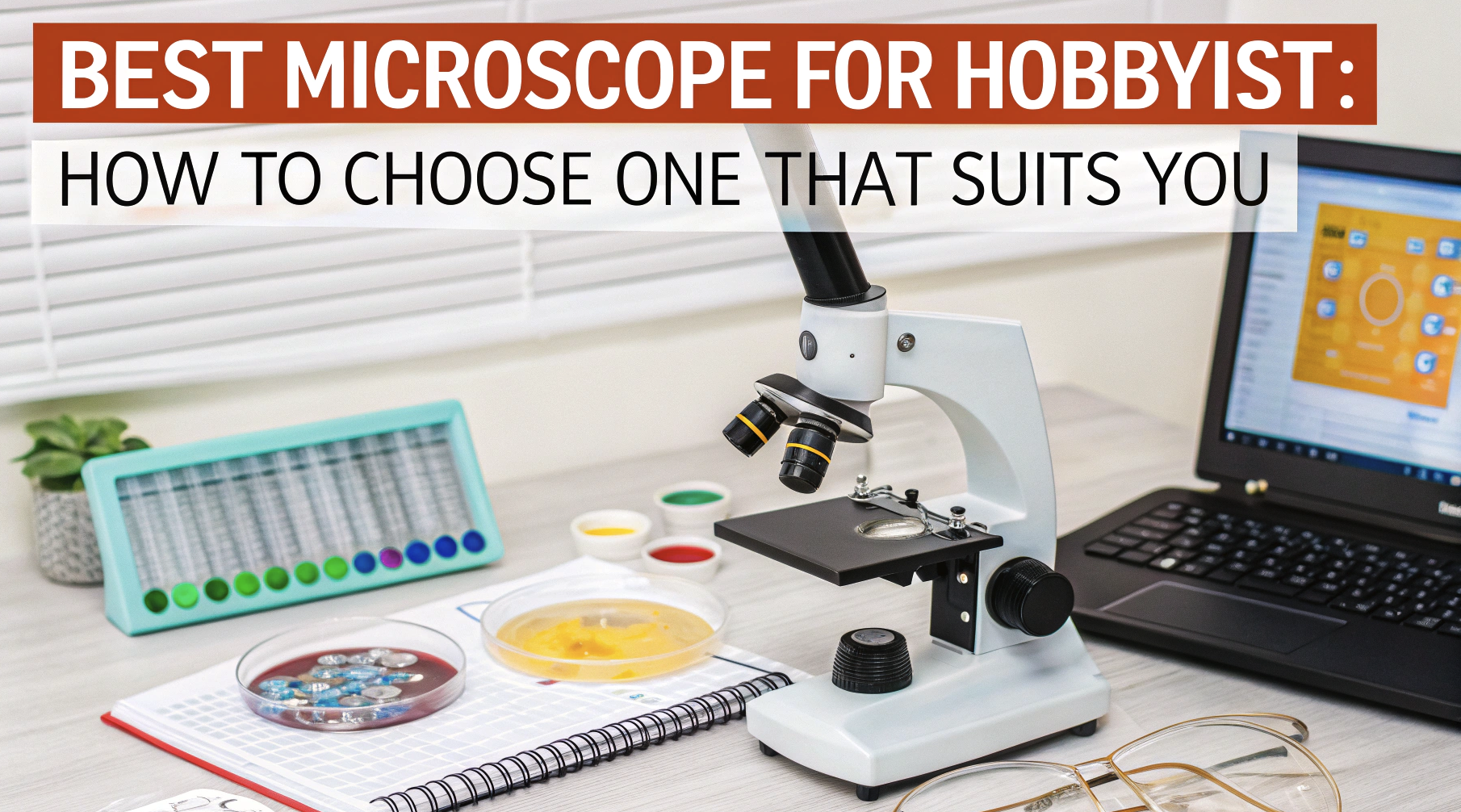
If you’re anything like me, the thrill of exploring the hidden details of everyday objects under a microscope never gets old. There’s something almost magical about peering into a world that’s invisible to the naked eye. I recall when I first began using microscopy; I was overwhelmed by the vast array of microscopes available. From simple magnifying glasses to sophisticated compound microscopes, the choices seemed endless. After countless hours of peering through lenses, experimenting with different models, and comparing features, I’ve gathered some valuable insights on what makes the best microscope for hobbyists like us.
This guide highlights key hobbyist microscope features and top models to help beginners or those upgrading find the right tool to explore the micro-world. So grab your lab coat (or maybe just a comfy chair), and let’s dive into the fascinating realm of hobbyist microscopy together! 😁
Types of Microscopes for Hobbyists
Compound Microscopes
Compound microscopes are the most common type of microscope used by hobbyists and professionals alike. These microscopes employ a combination of lenses to magnify the specimen, with the primary objective lens positioned close to the sample and the eyepiece lens located near the observer’s eye.
These microscopes are ideal for viewing thin, transparent specimens such as cells, bacteria, and small organisms. One of the key advantages of compound microscopes is their high magnification power, which can range from 40x to 1000x or more. This allows hobbyists to observe intricate details of their specimens that would be impossible to see with the naked eye.
However, it’s important to note that higher magnification doesn’t always equate to better image quality.
The resolution of the microscope, which is determined by the quality of the lenses and the wavelength of light used, plays a crucial role in the clarity and sharpness of the image. When considering a compound microscope, it’s essential to pay attention to the numerical aperture (NA) of the lenses. The NA is a measure of the microscope’s ability to gather light and resolve fine details. A higher NA generally results in better resolution and image quality.
The table below provides a comparison of the magnification and resolution of common objective lenses found in compound microscopes.
| Objective Lens Magnification | Numerical Aperture (NA) | Resolving Power (μm) |
|---|---|---|
| 4x | 0.10 | 2.75 |
| 10x | 0.25 | 1.10 |
| 40x | 0.65 | 0.42 |
| 100x (Oil Immersion) | 1.25 | 0.22 |
Stereo Microscopes
Stereo microscopes, also known as dissecting microscopes, are another popular choice among hobbyists. Unlike compound microscopes, stereo microscopes provide a three-dimensional view of the specimen, making them ideal for observing larger, opaque objects such as rocks, coins, insects, and plant structures.
Stereo microscopes typically have lower magnification powers compared to compound microscopes, ranging from 5x to 100x. One of the unique features of stereo microscopes is their ability to provide depth perception. By using two separate optical paths, one for each eye, stereo microscopes create a stereoscopic image that allows the observer to perceive the spatial relationships between different parts of the specimen. This is particularly useful when working with specimens that require manipulation, such as dissecting or preparing samples.
Stereo microscopes often come equipped with a variety of illumination options, including incident light (from above the specimen) and transmitted light (from below the specimen).
Some models even offer the ability to adjust the angle of the incident light, allowing for better visualization of surface textures and details. When choosing a stereo microscope, consider the working distance, which is the distance between the objective lens and the specimen. A longer working distance provides more room for manipulating the sample and using tools.
Digital Microscopes
In recent years, digital microscopes have gained popularity among hobbyists due to their ease of use and versatility. Digital microscopes combine the magnification capabilities of traditional microscopes with the convenience of digital imaging technology. Instead of using eyepieces, digital microscopes feature a built-in camera that captures images of the specimen and displays them on a computer screen or other digital device.
One of the main advantages of digital microscopes is their ability to capture and store high-quality images and videos of the specimens. This allows hobbyists to easily document their observations, share them with others, and analyze them using specialized software.
Many digital microscopes come with built-in measurement tools, enabling users to accurately measure the size and dimensions of their specimens without the need for additional equipment.
Digital microscopes offer a wide range of magnification options, with some models capable of achieving magnifications up to 1000x or more. However, it’s important to keep in mind that the resolution of the captured images is largely dependent on the quality of the camera sensor and the optics of the microscope.
When considering a digital microscope, pay attention to the camera’s resolution (measured in megapixels), the frame rate for live viewing, and the compatibility with your computer or digital device.
One notable advantage of digital microscopes is their portability. Many models are compact and lightweight, making them easy to transport and use in various settings, such as in the field or classroom. Some digital microscopes even
Factors to Consider When Choosing a Microscope
Magnification and Resolution
When selecting a microscope, one of the primary factors to consider is the magnification power. Magnification refers to the degree to which a specimen appears larger when viewed through a microscope compared to its actual size. For hobbyists, a magnification range of 40x to 1000x is generally sufficient for most applications. However, it’s important to understand that higher magnification doesn’t always guarantee better image quality.
Resolution, on the other hand, is the microscope’s ability to distinguish between two closely spaced points on the specimen. A microscope with high resolution will produce images with sharp, clear details. The resolution is determined by the quality of the lenses and the wavelength of light used.
As a general rule, the shorter the wavelength of light and the higher the numerical aperture (NA) of the lens, the better the resolution. To achieve the best balance between magnification and resolution, it’s recommended to use the lowest magnification that still allows you to see the desired level of detail. This is because as magnification increases, the amount of light reaching the specimen decreases, which can result in a darker and less sharp image.
The table below provides a general guide to the recommended magnification ranges for various specimen types.
| Specimen Type | Recommended Magnification Range |
|---|---|
| Bacteria, viruses | 400x – 1000x |
| Cells, tissue sections | 100x – 400x |
| Insects, plant parts | 20x – 100x |
| Coins, stamps | 5x – 50x |
Optical Quality
The optical quality of a microscope plays a vital role in determining the clarity, sharpness, and contrast of the images produced. High-quality optics ensure that the microscope can resolve fine details and minimize aberrations, such as distortion and chromatic aberration. When evaluating the optical quality of a microscope, pay attention to the type and quality of the lenses used.
Achromatic lenses are designed to reduce chromatic aberration, which occurs when different wavelengths of light focus at slightly different points, resulting in color fringes around the edges of the image. Plan-corrected lenses, on the other hand, are designed to provide a flat field of view, minimizing distortion and ensuring that the image remains sharp from the center to the edges.
Another factor to consider is the coating applied to the lenses. Anti-reflective coatings help to reduce glare and improve light transmission, resulting in brighter and higher-contrast images. Some high-end microscopes even use fluorite or apochromatic lenses, which provide the highest level of color correction and image quality.
Illumination
Proper illumination is key to achieving optimal image quality and ensuring comfortable viewing during prolonged use. When choosing a microscope, consider the type and quality of the illumination system. LED illumination has become increasingly popular in recent years due to its energy efficiency, long lifespan, and cool operating temperature.
LED lights produce bright, white light that closely resembles natural daylight, reducing eye strain and enhancing the visibility of specimen details. Some microscopes even offer adjustable LED intensity, allowing you to optimize the brightness for different specimens and viewing conditions.
Halogen illumination is another common option, particularly in high-end microscopes. Halogen bulbs provide bright, white light and excellent color rendering. However, they generate more heat than LED lights and have a shorter lifespan, typically requiring replacement every 500 to 1000 hours of use.
When evaluating the illumination system, also consider the type of illumination technique used. Brightfield illumination is the most common technique, where light is transmitted through the specimen from below.
Darkfield illumination, on the other hand, uses oblique light to illuminate the specimen from the sides, creating a dark background that enhances the contrast of transparent or translucent specimens. Some microscopes also offer phase contrast or differential interference contrast (DIC) techniques, which are particularly useful for visualizing unstained, transparent specimens.
Ease of Use and Durability
When investing in a microscope, it’s important to consider the ease of use and durability of the instrument. A well-designed microscope should be intuitive to operate, with smooth and precise focus mechanisms, easily accessible controls, and a comfortable eyepiece position.
The focus mechanism is one of the most critical aspects of a microscope’s ease of use. Look for a microscope with a smooth, fine focus adjustment that allows you to make precise adjustments without experiencing drift or backlash. Some microscopes also feature a coaxial focus system, where both the coarse and fine focus adjustments are controlled by a single knob, making it easier to switch between different magnifications without losing focus.
Durability is another key factor to consider, especially if you plan to use your microscope frequently or transport it to different locations.
Look for a microscope with a sturdy, metal frame that can withstand regular use and handling. The stage should be solid and stable, with a smooth, scratch-resistant surface that can accommodate a variety of specimen slides. When evaluating the durability of a microscope, also consider the quality of the mechanical components, such as the gears, bearings, and rack-and-pinion systems.
High-quality components ensure smooth, precise movements and minimize wear and tear over time. Some microscopes even come with dust covers or carrying cases to protect the instrument during storage and transport.
Price and Budget
Microscopes come in a wide range of prices, from entry-level models costing a few hundred dollars to high-end research-grade instruments that can cost tens of thousands of dollars. As a hobbyist, it’s essential to determine your budget and select a microscope that offers the best value for your money.
When considering the price of a microscope, it’s important to balance your needs and expectations with your available budget. While it may be tempting to opt for the cheapest model available, keep in mind that lower-priced microscopes often compromise on optical quality, durability, and features. On the other hand, investing in a more expensive microscope with advanced features and high-quality optics may be overkill for your intended use.
To get the best value for your money, consider your specific needs and prioritize the features that are most important to you. For example, if you primarily plan to use your microscope for observing larger specimens, such as insects or rocks, a stereo microscope with a lower magnification range and a longer working distance may be a better choice than a compound microscope with high magnification.
Similarly, if you plan to capture images or videos of your specimens, a digital microscope with a high-resolution camera and user-friendly software may be worth the extra investment.
When setting your budget, also consider the long-term costs associated with owning a microscope, such as the cost of accessories, replacement parts, and maintenance. Some microscopes may require additional investments in slides, cover slips, stains, or cleaning supplies. By factoring in these costs upfront, you can ensure that you select a microscope that fits within your overall budget and provides the best value for your specific needs.
Top Microscope Recommendations for Hobbyists
Best Overall: Nikon Eclipse E200 Compound Microscope
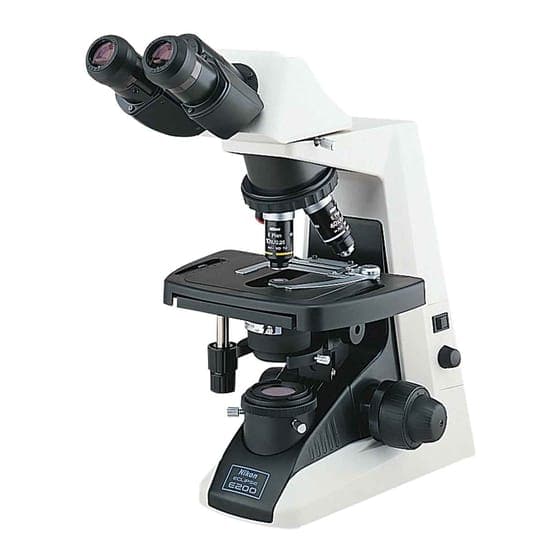 The Nikon Eclipse E200 is a top-of-the-line compound microscope that offers exceptional optical quality, versatility, and ease of use. This microscope features high-quality CFI60 optics, which provide sharp, clear images with excellent contrast and resolution.
The Nikon Eclipse E200 is a top-of-the-line compound microscope that offers exceptional optical quality, versatility, and ease of use. This microscope features high-quality CFI60 optics, which provide sharp, clear images with excellent contrast and resolution.
The E200 comes equipped with four objective lenses (4x, 10x, 40x, and 100x), allowing for a wide range of magnification options suitable for various specimens.
One of the standout features of the Nikon Eclipse E200 is its Siedentopf-type binocular head, which provides a comfortable viewing experience with adjustable interpupillary distance and diopter settings.
The microscope also boasts a built-in 6V/30W halogen illumination system with adjustable intensity, ensuring optimal lighting conditions for your specimens.
The Nikon Eclipse E200 is built to last, with a sturdy, metal frame and a scratch-resistant stage. The coaxial coarse and fine focus knobs provide smooth, precise focusing, while the reversible nosepiece allows for easy switching between objectives.
Although the Nikon Eclipse E200 is priced higher than some entry-level microscopes, its exceptional quality and features make it an excellent investment for serious hobbyists and professionals alike.
Best Value for Money: AmScope T490A-DK Compound Trinocular Microscope
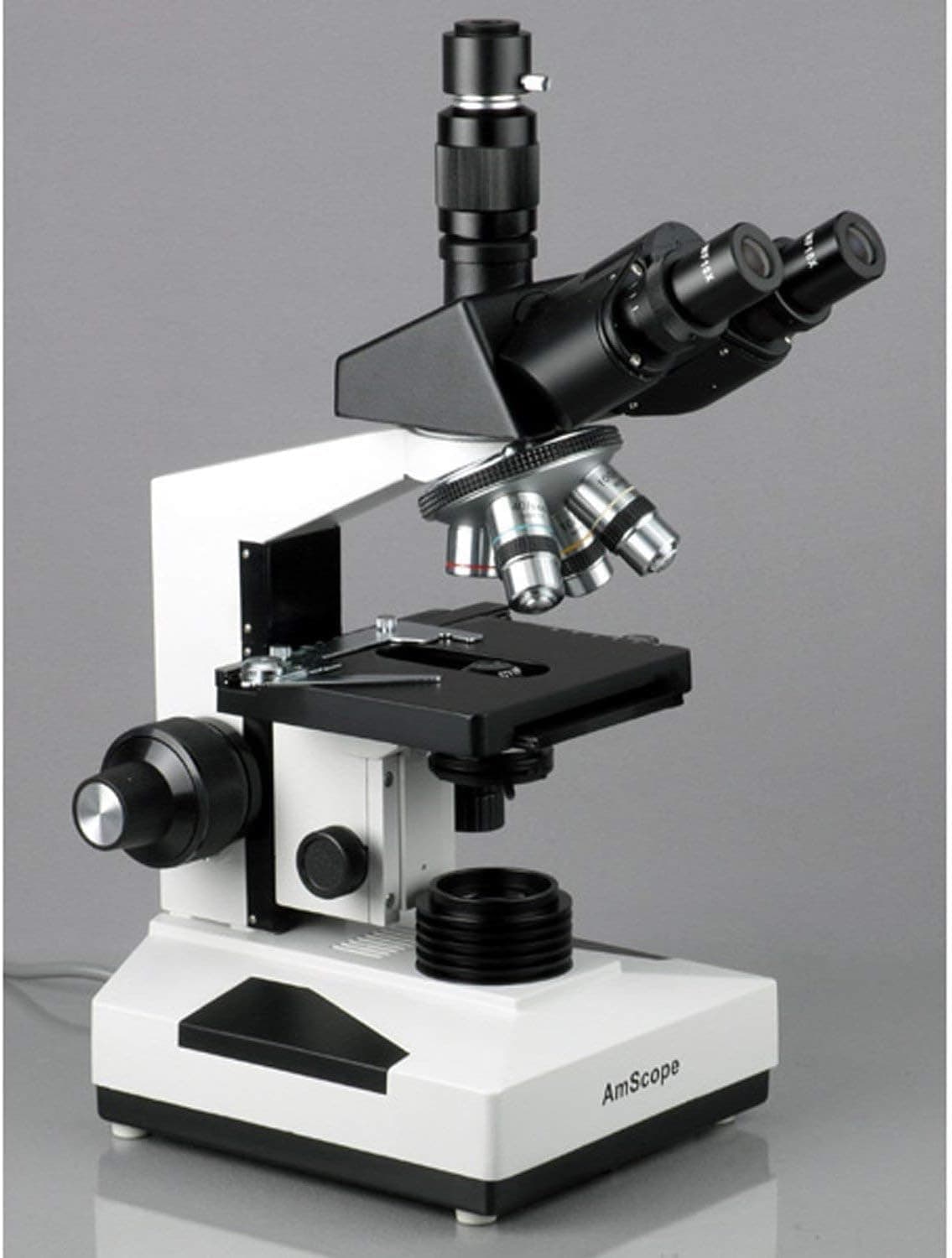 Renowned for its exceptional optical clarity and robust performance, AmScope T490A-DK is an essential tool for students, professionals, and hobbyists alike.
Renowned for its exceptional optical clarity and robust performance, AmScope T490A-DK is an essential tool for students, professionals, and hobbyists alike.
Featuring a wide field of view, it allows you to explore intricate details with ease and precision. Its high-resolution optics provide stunning clarity, making it the microscope of choice in laboratories, educational institutions, and research settings.
The AmScope T490A-DK is an excellent choice for hobbyists looking for a high-quality compound microscope at an affordable price point. This microscope offers a magnification range of 40x to 1600x, making it suitable for a wide variety of specimens, from bacteria to blood cells.
The T490A-DK features a trinocular head, which allows for the attachment of a camera for capturing images and videos of your specimens.
The microscope comes equipped with four plan achromatic objectives (4x, 10x, 40xS, and 100xS) that provide sharp, clear images with minimal distortion.
The built-in LED illumination system offers adjustable intensity and a lifespan of up to 50,000 hours.
One of the advantages of the AmScope T490A-DK is its mechanical stage with a double-layer design, which provides a large, stable platform for your specimens. The coaxial coarse and fine focus knobs ensure precise, smooth focusing, while the adjustable Abbe condenser with iris diaphragm allows for optimal contrast and resolution. With its combination of quality optics, versatile features, and affordable price, the AmScope T490A-DK is an excellent value for money option for hobbyists.
Trusted by leading scientists and educators, the AmScope Trinocular Compound Microscope is your gateway to groundbreaking discoveries and endless exploration.
Best for Beginners: Swift SW350T Compound Microscope
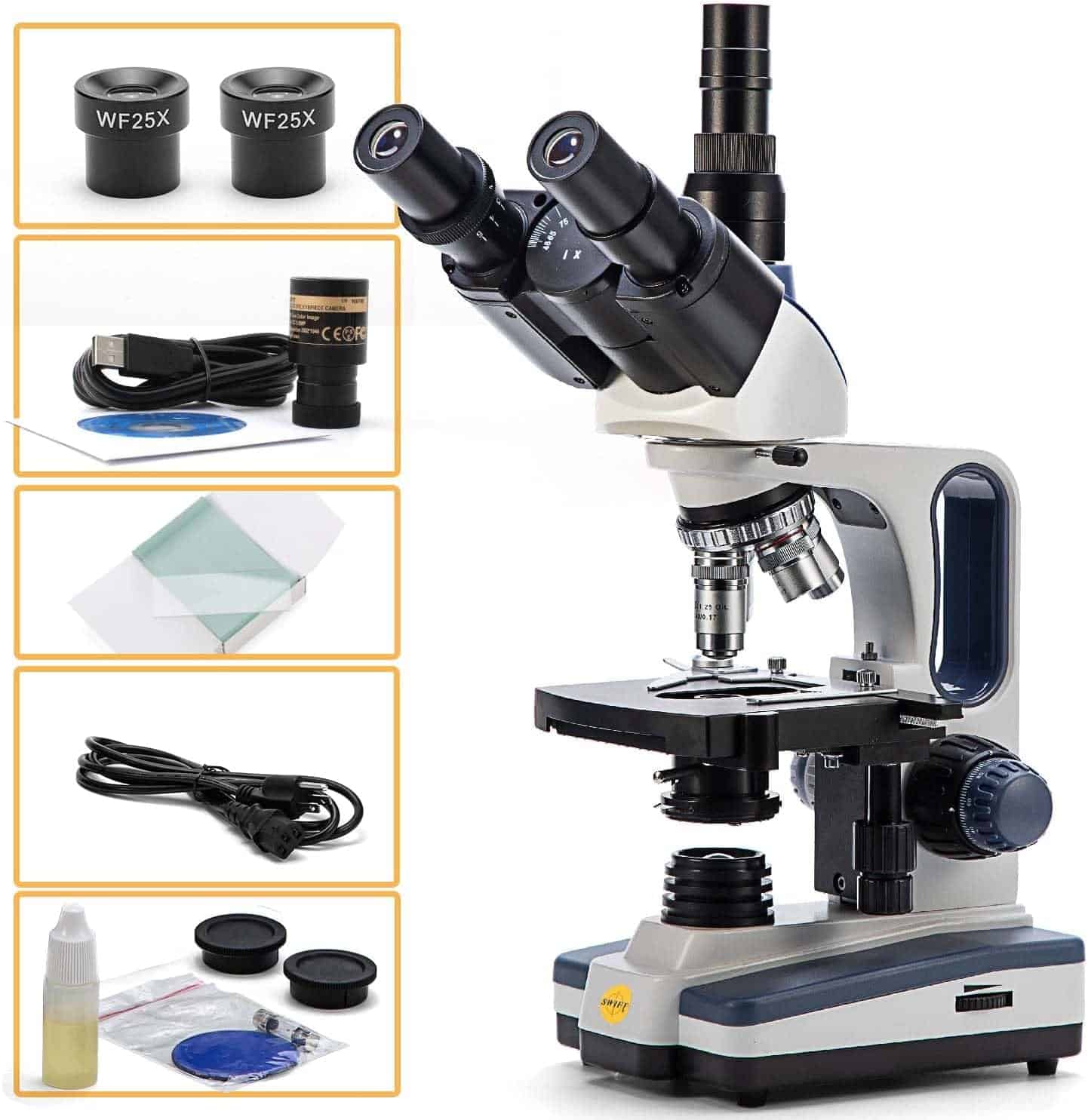 The Swift SW350T is an ideal microscope for beginners who are just starting to explore the world of microscopy. This compound microscope offers a magnification range of 40x to 2500x, providing ample opportunities for observing a variety of specimens.
The Swift SW350T is an ideal microscope for beginners who are just starting to explore the world of microscopy. This compound microscope offers a magnification range of 40x to 2500x, providing ample opportunities for observing a variety of specimens.
The SW350T features a monocular head with a 360-degree rotatable eyepiece, making it easy to share views with others or adjust the viewing angle for comfort.
The microscope comes with four DIN achromatic objectives (4x, 10x, 40x, and 100x) that provide clear, sharp images.
The built-in LED illumination system offers adjustable intensity and a long lifespan, ensuring consistent lighting for your specimens. One of the beginner-friendly features of the Swift SW350T is its double-disc diaphragm, which allows for easy adjustment of the aperture size to control the amount of light entering the microscope.
The coaxial coarse and fine focus knobs provide smooth, precise focusing, while the large, stable stage offers ample space for your specimen slides. The Swift SW350T also comes with a range of accessories, including sample slides, a blue filter, and a dust cover, making it a comprehensive starter kit for beginners.
Best Digital Microscope: Celestron 44308 LCD Digital Microscope II
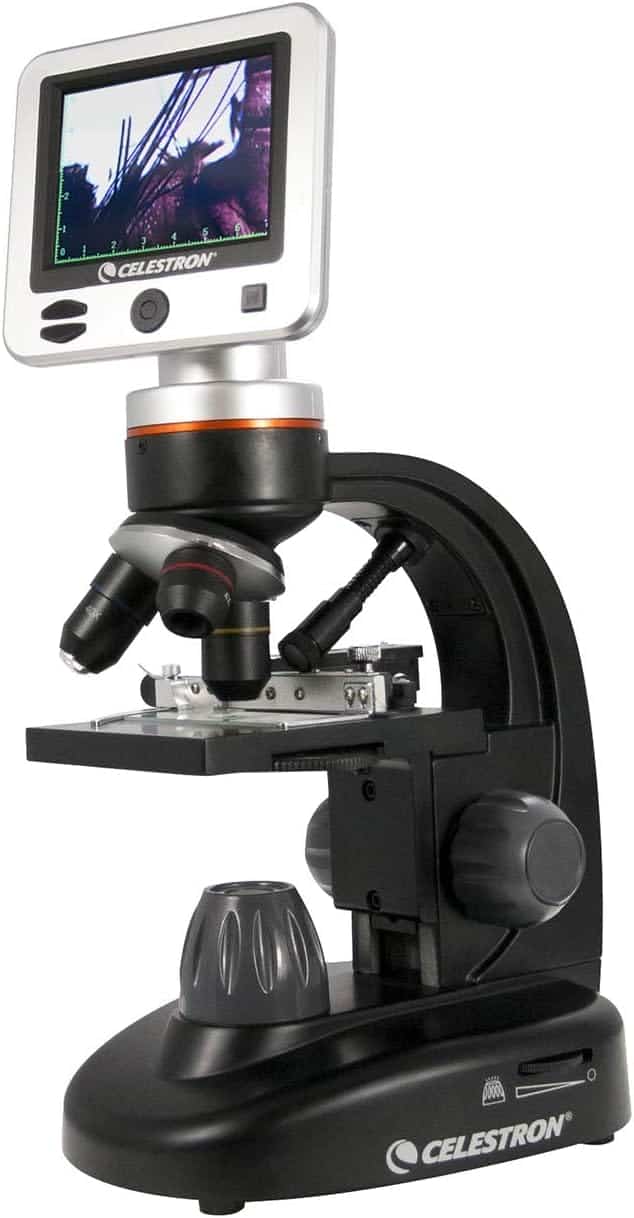 The Celestron 44308 LCD Digital Microscope II is a versatile, user-friendly digital microscope that offers a unique blend of traditional microscopy and modern digital imaging. This microscope features a large, 4.3-inch LCD screen that provides a clear, real-time view of your specimens without the need for an eyepiece.
The Celestron 44308 LCD Digital Microscope II is a versatile, user-friendly digital microscope that offers a unique blend of traditional microscopy and modern digital imaging. This microscope features a large, 4.3-inch LCD screen that provides a clear, real-time view of your specimens without the need for an eyepiece.
The 44308 offers a magnification range of 40x to 2400x, with three objective lenses (4x, 10x, and 40x) that provide sharp, detailed images.
The microscope also features a 5MP digital camera that captures high-quality images and videos of your specimens, which can be easily transferred to a computer via the USB port.
One of the standout features of the Celestron 44308 is its adjustable LED illumination system, which includes both upper and lower illumination for optimal lighting of your specimens. The microscope also features a range of built-in digital capabilities, including adjustable brightness and contrast, digital zoom, and a measuring function for precise specimen analysis.
The Celestron 44308 LCD Digital Microscope II is designed with ease of use in mind, making it an excellent choice for hobbyists, students, and educators.
The microscope comes with a sturdy metal frame, a large, stable stage, and a range of accessories, including prepared slides, a carrying case, and a AC adapter. With its combination of digital imaging capabilities and traditional microscopy features, the Celestron 44308 offers a unique and engaging way to explore the microscopic world.
| Microscope Model | Magnification Range | Illumination Type | Digital Imaging | Price Range |
|---|---|---|---|---|
| Nikon Eclipse E200 | 40x – 1000x | Halogen | No | $1000 – $1500 |
| AmScope T490A-PL | 40x – 2000x | LED | Optional | $300 – $500 |
| Swift SW350T | 40x – 2500x | LED | No | $100 – $200 |
| Celestron 44308 | 40x – 2400x | LED (upper & lower) | Yes (built-in) | $200 – $300 |
When choosing a microscope, it’s essential to consider your specific needs, budget, and level of experience. The Nikon Eclipse E200 offers exceptional quality and features, making it an excellent choice for serious hobbyists and professionals. The AmScope T490A-PL provides a balance of quality and affordability, with the option to add digital imaging capabilities.
For beginners, the Swift SW350T offers a comprehensive starter kit at an entry-level price point. Lastly, the Celestron 44308 LCD Digital Microscope II combines traditional microscopy with digital imaging, making it a unique and engaging option for hobbyists and educators.
Ultimately, the best microscope for you will depend on your specific interests, intended applications, and budget. By carefully considering the factors discussed in this guide and evaluating your options, you can select a microscope that will provide you with years of enjoyment and discovery in the fascinating world of microscopy.
Accessories and Add-ons for Hobbyist Microscopes
When delving into the world of microscopy, it’s essential to have the right accessories and add-ons to enhance your experience and maximize the potential of your microscope. These accessories can help you prepare specimens, improve image quality, and expand the capabilities of your microscope.
One of the most essential accessories for any microscope user is a set of high-quality slides and cover slips. Slides provide a flat, transparent surface on which to mount your specimens, while cover slips help to protect the specimen and create a uniform thickness for optimal viewing. It’s important to choose slides and cover slips that are clean, scratch-free, and made from high-quality glass to ensure the best possible image quality.
Another key accessory is a cleaning kit, which typically includes lens cleaning solution, microfiber cloths, and air blowers. Regular cleaning of your microscope’s lenses and components helps to maintain image clarity and prolong the life of your instrument. Always follow the manufacturer’s guidelines when cleaning your microscope to avoid damaging the delicate optics.
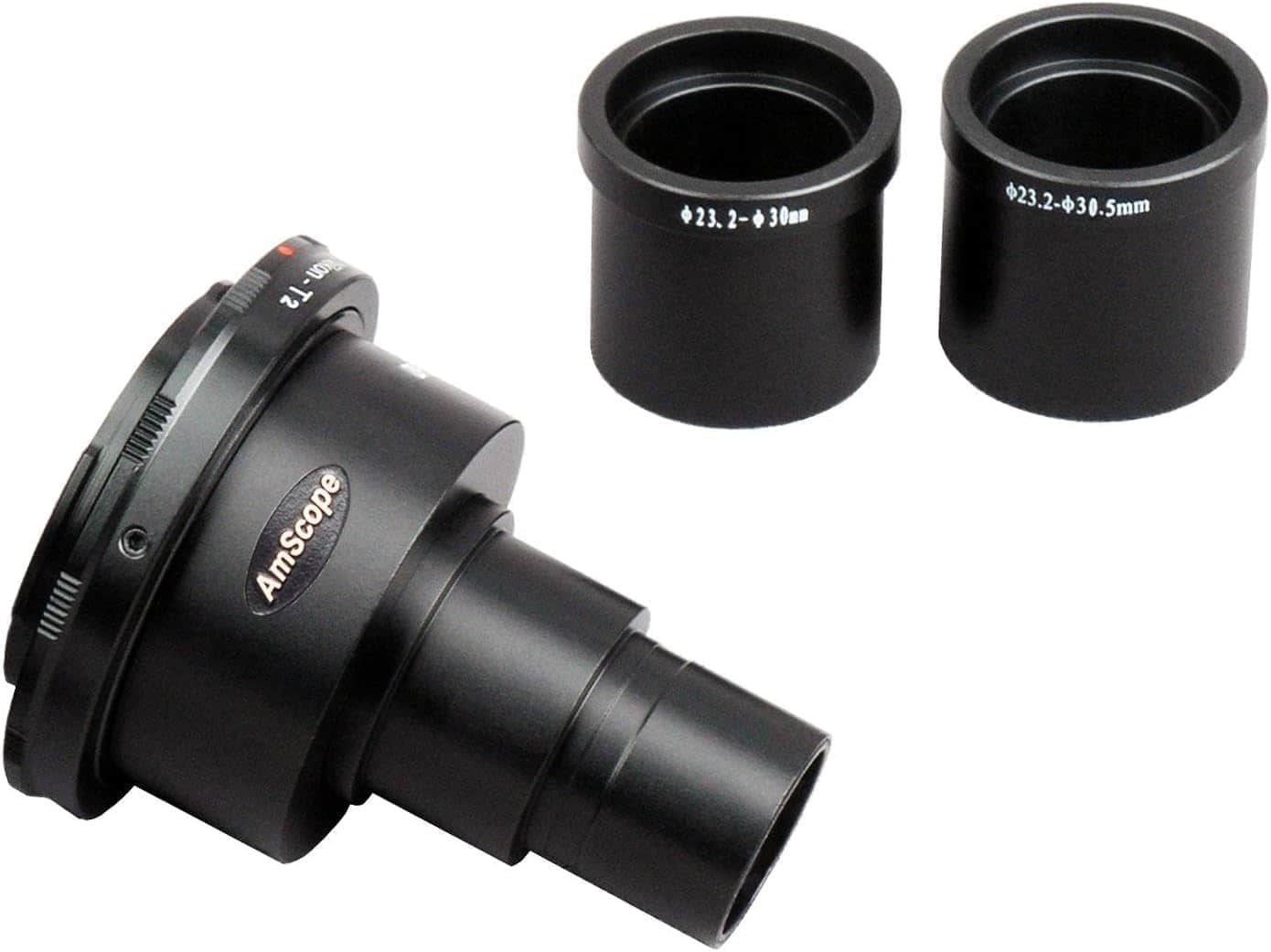
In addition to these essential accessories, there are several add-ons that can enhance your microscopy experience and expand the capabilities of your instrument.
One popular add-on is a camera adapter, which allows you to attach a digital camera or smartphone to your microscope for capturing images and videos of your specimens. Camera adapters come in various designs, from simple smartphone mounts to more advanced systems that integrate with DSLR cameras.
Another useful add-on is a stage micrometer, which is a microscope slide with a precise scale etched onto its surface. Stage micrometers allow you to calibrate your microscope and take accurate measurements of your specimens. This is particularly important for scientific research and documentation, as well as for comparing the sizes of different specimens.
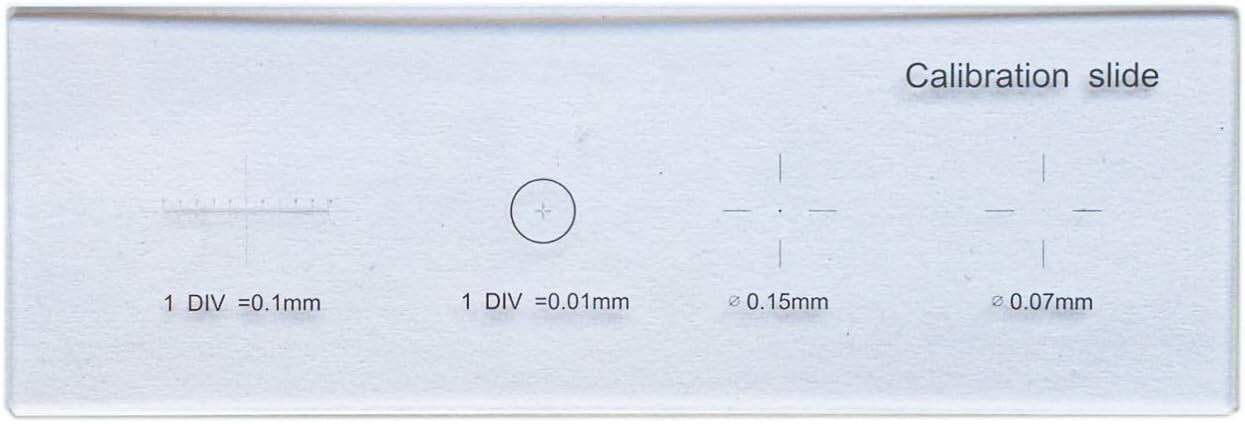
For those interested in exploring the world of live microorganisms, a stage warmer can be a valuable add-on. Stage warmers help to maintain a constant temperature for your specimens, which is essential for observing the behavior and development of live organisms such as bacteria, protozoa, and small invertebrates.
| Accessory/Add-on | Purpose | Price Range |
|---|---|---|
| Slides and Cover Slips | Mounting specimens for observation | $5 – $50 |
| Cleaning Kit | Maintaining image clarity and microscope longevity | $10 – $30 |
| Camera Adapter | Capturing images and videos of specimens | $20 – $200 |
| Stage Micrometer | Calibrating microscope and measuring specimens | $50 – $100 |
| Stage Warmer | Maintaining a constant temperature for live specimens | $100 – $300 |
When selecting accessories and add-ons for your microscope, it’s important to consider compatibility with your specific model and your intended applications.
Some accessories, such as camera adapters, may require specific mounting systems or software to function properly. Always research the compatibility of an accessory before purchasing to ensure that it will work seamlessly with your microscope. Investing in high-quality accessories and add-ons can greatly enhance your microscopy experience and allow you to explore new avenues of observation and research.
Maintenance and Care Tips for Your Microscope
Proper maintenance and care are essential for ensuring the longevity and optimal performance of your microscope. By following a few simple guidelines, you can keep your microscope in excellent condition and avoid costly repairs or replacements.
One of the most important aspects of microscope maintenance is regular cleaning. Dust, dirt, and oil from your skin can accumulate on the lenses and other components, leading to reduced image quality and potential damage to the delicate optics. To clean your microscope, start by using an air blower to remove loose dust and debris.
Then, gently wipe the lenses with a microfiber cloth or lens tissue, using a circular motion that starts from the center of the lens and moves outward. For stubborn smudges or fingerprints, use a small amount of lens cleaning solution on the cloth, but avoid applying the solution directly to the lens. In addition to cleaning the lenses, it’s important to keep the microscope body and stage clean. Use a soft, dry cloth to wipe down the exterior of the microscope, paying special attention to the stage and any crevices where dust may accumulate.
If necessary, you can use a slightly damp cloth to remove stubborn dirt, but be sure to dry the microscope thoroughly afterward to prevent moisture damage.
Proper storage is another key aspect of microscope maintenance. When not in use, keep your microscope covered with a dust cover or store it in a cabinet or case to protect it from dust, moisture, and other environmental factors. Avoid storing your microscope in areas with high humidity, extreme temperatures, or direct sunlight, as these conditions can damage the optics and electronic components.
If your microscope has a mechanical stage or other moving parts, it’s important to lubricate them periodically to ensure smooth operation and prevent wear and tear.
Use a small amount of high-quality lubricant specifically designed for microscopes, and apply it sparingly to the moving parts as directed by the manufacturer. Avoid using excessive amounts of lubricant, as this can attract dust and debris.
| Maintenance Task | Frequency | Tools Required |
|---|---|---|
| Lens Cleaning | As needed | Air blower, microfiber cloth, lens cleaning solution |
| Body and Stage Cleaning | Monthly | Soft, dry cloth; slightly damp cloth for stubborn dirt |
| Storage | After each use | Dust cover or cabinet/case |
| Lubrication | Every 6-12 months | High-quality lubricant specific for microscopes |
Regular maintenance and care can help extend the life of your microscope and ensure that it continues to provide high-quality images for years to come. By setting aside a small amount of time each month to clean and maintain your microscope, you can avoid more serious problems down the road and enjoy uninterrupted use of your instrument.
📍Takeaways
In this comprehensive guide, we have explored the fascinating world of microscopy and provided valuable insights to help you choose the best microscope for your needs as a hobbyist. We began by discussing the different types of microscopes available, including compound, stereo, and digital microscopes, each with their unique advantages and applications.
Remember, the key to a rewarding microscopy experience lies in selecting the right instrument for your needs, investing in quality accessories, and maintaining your microscope with care. By following the advice and recommendations provided in this guide, you can confidently embark on your journey as a hobbyist microscopist and uncover the beauty and complexity of the world around you.

